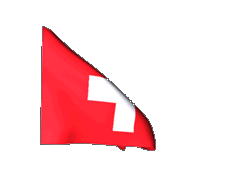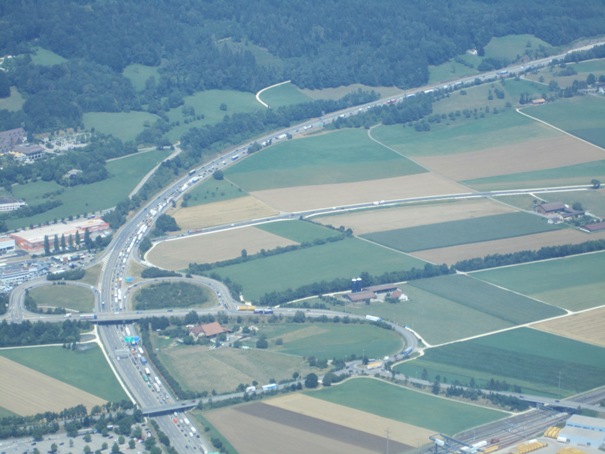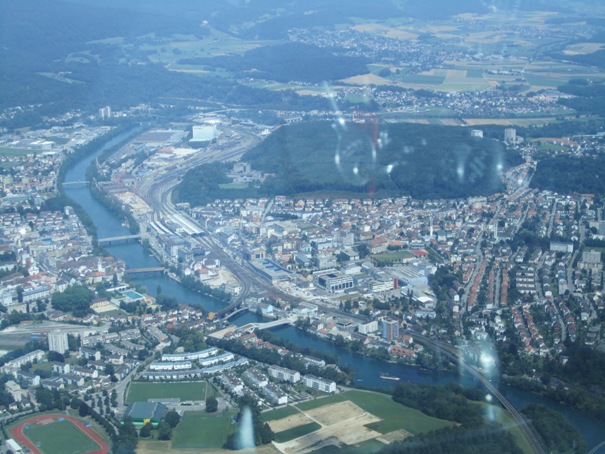01.08.2012: No flying today, but it’s the Swiss National Holiday with lot’s of fireworks. We were wondering whether one can see them from the air when landing in Zurich.

02.08.2012: Part of becoming a flight test advisor for EAS is to do a checkflight with the chief flight test advisor. He lives south of the alps and I have tried already twice to fly to Locarno to meet him., but once I had to cancel the flight and the other time to turn back due to weather. When I called him a few days ago he told me that he will fly to Bressaucourt (LSZQ) near the French border today, so we agreed to meet there. Bressaucourt is about an hour west of Lommis, so about the same distance as to Locarno, but without the alps to cross.
I first flew north west to pass the CTR of Zurich Airport on the north side, then past the Leibstadt nuclear power plant, which is always easy to find. Luckily we don’t have silly prohibited areas around these plants like in France or Germany, it’s no problem to fly very close or even over them.

Then I flew along the Rhine, here Laufenburg, Switzerland on the left (South) and Laufenburg, Germany on the right (North) side of the Rhine.

From there I continued to Pratteln and then through the TMA of Basel via Delémont towards Bressaucourt.
Below Basel, where the Rhine turns North.

The cloud base was quite low around Basel, approximately 3’000 ft, at one place I overflew one of the many boy scout camps that take place during these weeks.

After the landing in Bressaucourt we first went through some of the test flights that are part of the flight test program to discuss the essential points to look for and then went to repeat them with my plane. We did the climb stall, as well as some of the stability tests during climb and cruise.
We then returned to Bressaucourt where we had lunch at the airport restaurant, which only opened recently. Before flying home again I took a picture of my plane next to the one of Ernesto, a Zenith that was long on my list of possible planes to build until I decided for the then new SportCruiser.

The flight home was uneventful, but a bit bumpy due to around 25 – 30 kts of wind at 5’000 ft.

On the highway north from Olten towards Basel I saw a long queue, definitely faster to fly over it.

From there I passed Olten,…

…and Gösgen nuclear power plant. All nuclear power stations shall be switched off in a few years, I wonder however where the power shall come from afterwards.

After passing Zurich again I flew back towards the Lake of Constance, always a nice sight.

18.08.2012: I’m on vacation in Canada, and so far without doing any flying. I have hoped to find some Beaver Seaplane rides, but so far without success. I guess we are in the wrong area for that, as we are mostly along the Atlantic coast in the eastern part of Canada. We did however pass some interesting museums during the initial week of our tour, including the Canadian Aviation Museum in Ottawa and the Royal Canadian Air Force Museum in Trenton. Here a few pictures taken in each of them:
Canadian Aviation Museum
The museum is located at Rockport airport, which lies just a few km east of downtown Ottawa. Below a picture of the main building, which I have visited already some years ago.

Since my last visit they have put up a new building, but it was not yet open for visitors. That’s a good reason to come back in the future…

The entrance hall is already quite spectacular, with a training jet hanging upside down from the ceiling. These jets are also used by the aerobatics team of the Royal Canadian Air Force, the Snowbirds.

Below a few pictures of planes, and I have concentrated mostly on seaplanes. First a beautifully restored Curtis Seagull, one of many Curtis planes in the museum.

Below a Curtis HS-2L, rebuilt from a wreck that sank in a lake in Ontario in 1922 and was salvaged in 1969 after 47 years in the water. They could only use a few parts from that wreck, but also used parts from some other planes, so around 2/3 are original parts.

The De Havilland DHC-2 Beaver, the first prototype which was sold to a customer after flight testing (imagine doing that today with EASA rules!).


Then a Stinson SR Reliant,…

… a De Havilland D.H.83C Fox Moth,…

and a Junkers W.34f/fi, a very rare plane and one of the first all metal aircraft.


The last plane on floats was a Bellanca CH-300 Pacemaker.

They also had two homebuilts, one an Epervier X-01, a project from Sherbrooke University.

Here another homebuilt, which I have not identified yet.

The museum concentrates on planes with a strong Canadian connection, and has some unique aircraft such as ths Canadair CL-84 Dynavert, an early attempt to build a transitioning aircraft such as today’s Bell/Boeing V-22 Osprey.

Here a view over part of their collection, I am looking forward to seeing the new building at my next visit in a few years.

National Air Force Museum of Canada
The Royal Canadian Air Force museum is located at Trenton Airbase, which is one of the largest bases of the Canadian Air Force. When arriving at the museum entrance we could watch a Lockheed Hercules doing touch and go’s.
The museum has an excellent collection of many aircraft used by the Air Force, from a Burgess-Dunne Floatplane, which was the first aircraft operated by the Air Force…

…via a mix of second world war aircraft, such as this Hurricane…

…and Spitfire…

…to most planes operated since that time. This includes everything, from this small Chipmunk…

…via this Canadair Argus, CL-28/CP-107,…

…to the Lockheed, CC-130 E Hercules.

They even have an F/A-18, or rather CF-118 E Hornet.

The collections also includes some aircraft never used by the RCAF, which however represent significant milestones in the development of jet aircraft, such as a MIG-21 and this Hawker F-6 Hunter, which they received from the Swiss Air Force. Quite a surprise to find one of them here.

